
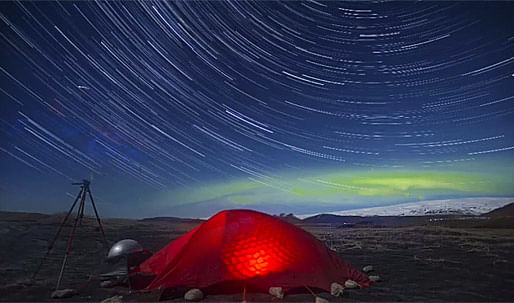
In late November 2012, London's The Bartlett School of Architecture Unit 3 embarked on an expedition to Iceland.
Warmed by the Gulf Stream, endless geysers and caught between two major tectonic plates, this land of endless volcanic activity is also home to Europe's largest glacier.
Twelve 2nd and 3rd year students designed, built and tested a series of shelter/surveying devices to research and charted varied aspects of Iceland.
These 'constructs' allowed them to record, test and live in a wide range of sites, from urban Reykjavik to the volcanic beaches of Vik; from the glacier lakes in the south and boiling landscapes, to high mountain plateaus at 20 degrees below zero. Living in their shelter for up to four days, the structure performed as active laboratories and testing beds for an array of experiments to understand specific aspects of the sites in question.
A new film produced following the expedition (see below) shows each student's exploration of the Icelandic landscape and the social, economic and environmental issues facing the country today, such as high alcohol taxation, fuel cell technology and WiFi signal strength in Reykjavik.
The studio was structured into two major sections as the program explains:
Project 1- shelter/survey
Mobility and adaptability are pre-requisites for survival in a changing environmental context. Generations of farmers in this harsh climate have lived off the land they inhabit. Some farms and residences today are still built without foundations, and moved when the earth starts shifting too close by. Project 1 will see us assembling the equipment for our quest. We will be in the workshop to test innovative materials, explore the light and the collapsible, the indestructible and the temporary, the breathable and the wind-tight. Advanced fabrication methods will help to tackle tricky junctions. Versatility is the key to dealing with unforeseen circumstances. Your design will be your observatory and your shelter for several days whilst charting your site, at 1:1, living and breathing. This shelter/observatory will allow you to chart the site and define the program for you building in project 2. Make sure it fits in the check-in luggage.
Project 2 - building
Taking into account the unique nature of Iceland's history and culture, we will raise strategic questions and address real-time issues that concern the people of this nation after their economic turmoil. Housing, schools and cultural interventions are real needs and hamper social and economic progress.
Could the rich natural resources help to devise new and innovative construction methods that are embedded in the local culture? In a country without forests will the jetsome and the floatsome of the industrialized nations establish new sustainable construction techniques? One thing is certain, Iceland has never been in a better position to establish its own very site specific architectural language and to illustrate a successful symbiosis between man and nature.
How will you represent your work to address the community and to usefully inform specific construction processes? How will you draw your building to explore its performance over time? Who will be your client? The municipality? A family you have met on your journey? Your representation methods need to be tailored to the user. 1:1 prototypes will be an integral part of the design process and once installed, tested and monitored will inform your technical dissertation. This is your opportunity to show your skills and communicate your ideas with access to an unprecedented archive and network of knowledge, in this new horizon.
"As a unit director, I can say that it was amazing to see how the shelters performed through out a catalog of different landscapes, from urban to natural, and how the students were able to feed the discoveries and research back into their present building designs, which is the present phase they find themselves in." says David Garcia, one of the two professors leading the Iceland Expedition unit. "Another realization is, that there is no better stimuli for the students to perform their utmost, than to know that they will be inhabiting their own design."
A few selected student projects in more detail:
Wearable Observatory
Student: Harry Clover
Position in the film: 7:09
My project was to make a wearable observatory for the night sky adapted for travel to remote areas of Iceland where the atmosphere can be exceptionally clear and without glare. The flexibility of a wearable shelter enables one to exploit brief windows within the cloud-cover. The northern lights are often only visible from certain vantage points and in various areas of the sky so it is important to be 1) mobile, 2) away from ambient light, 3) able to record 360°of the night sky, and 4) heavily insulated in both the mobile and the stationary mode.
The helmet is a transparent mirrored dome that, once unscrewed and attached to the unfolded tent, allows the occupant to view the sky while lying within a warm and protected environment. A camera on a tripod outside simultaneously records the 360-degree reflection of the sky on the dome through long-exposure photographs at intervals of between 5 and 30 seconds.

Ice as Structure
Student: Lisa McDanell
Position in the film: 13:27
The aim of my shelter was to test the structural possibilities that could be achieved when using ice as a medium to reinforce materials with no structural properties. I designed an aluminum frame which acted as an armature within which a dome of stretchy fabric could be pulled out and extended to form a habitable space. This space could be reconfigured from within using a series of strings and pulleys. The aluminum frame incorporated a spraying system, also controllable from within the shelter, which could moisten the stretched fabric. This would then freeze overnight and act as a wind break in its hardened state. The strength of the frozen fabric was tested by releasing each point from which it had been stretched. The outcome of testing the material was successful, and the stretched fabric when frozen held its from perfectly. I then charted the melting of the shelter when the sun rose, observing the patterns of movement as the fabric slowly crumbled and cracked as it lost its frozen structural properties.
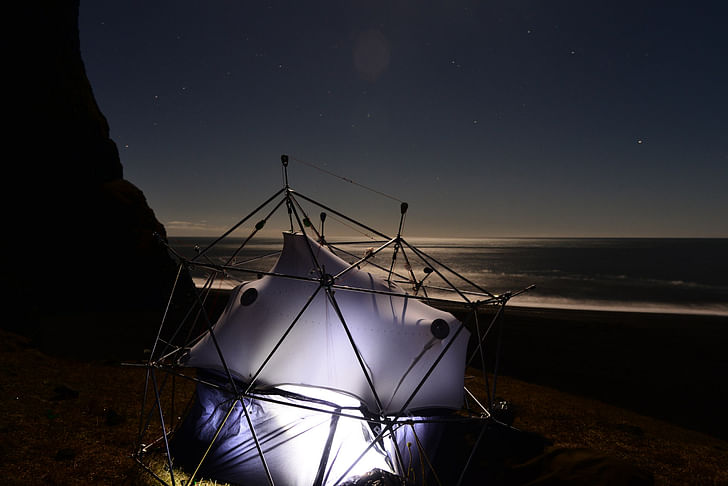
Recording Landscapes
Student: Tomiris Kupzhassarova
Position in the film: 25:20
In designing my shelter, I was interested in ways landscapes could be captured through the sounds they produce. The structure has two parts to it. The inside fabric layer that performs as a recording system, threaded with wires that connect recording devices with switches and power supply. The system enables recording of the soundscape of any location, capturing multitude of locally picked sounds. The inner layer can be attached to the structural part of the tent that is of the shape of a dodecahedron, placing each recorder at one of its sides and allowing three-dimensionality of the landscape recordings played.
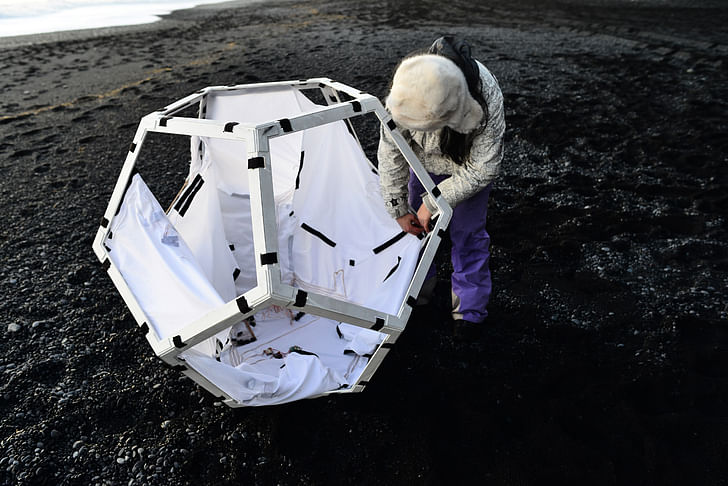
Borrowed Steam
Student: Claire Haugh
Position in the film: 5:20
My project focused on Iceland‘s massive geothermal resources and how, on a small scale, I could tap into them. I was interested in borrowing heat from the many steam outlets that can be found in the lcelandic environment, in order to heat my tent using a series of chambers. I pitched my shelter in various locations some of which were specific sites that I knew were sources of steam and others where I felt I could test the tent as a basic shelter without using its heated external skin.
My sites were, the beach at Vik, the Jökulsárlón ice lake and the Hveragerði steam vents.

Aquatic Research Shelter
Student: Sam Tan
Position in the film: 17:22
Iceland has always been heavily reliant on its aquatic environments. Increasingly, with the modernization of fishing mechanisms and techniques as well as rising sea temperatures, the composition of these environments is changing. My shelter analyzes the aquatic environments of Iceland, looking at fish species, fish populations, microscopic life and its abundance.
Fish traps, which are spread along each tentacle, are used to catch fish because of its passivity and unobtrusiveness, in contrast to commercial fishing methods, which have driven fish stocks into decline and reduced biodiversity. Aquatic life is attracted through lights, the lights attract plankton which subsequently attract zooplankton and organisms further up the trophic pyramid, the idea being to encourage an ecosystem to flourish around the tentacles.
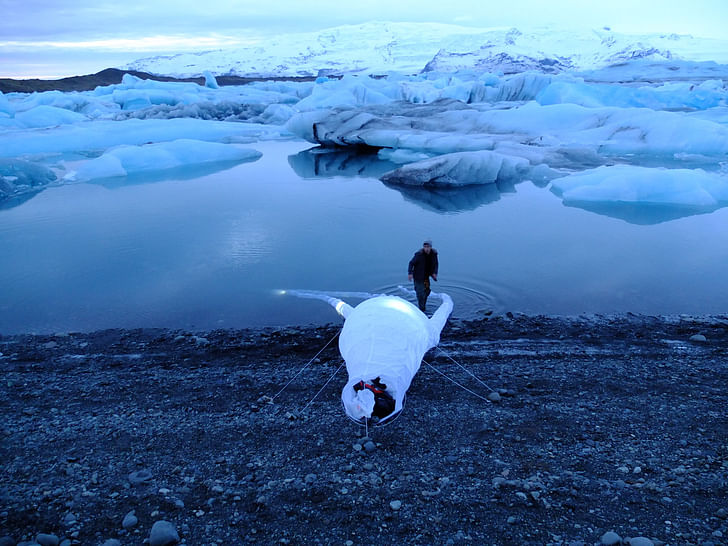
Algae Greenhouse
Student: Him Wai Lai
Position in the film: 9:10
For the past decade, the Icelandic government has been a major advocate of research into the production of hydrogen (H2) and the practical application of fuel-cell technology, hoping to replace as much of its fossil-fueled based transportation systems with H2 powered equivalents sometime in the near future.
One method of producing hydrogen is to extract it from algae, which when grown under specific conditions, will produce the gas as a natural by-product of its own metabolic processes. As Iceland has an abundance of 200 algae species, my proposal was to create a shelter that could, by day and night, act as a micro-laboratory for the sampling and culturing of species that could be found in geothermal hotspots and euthrophic lakes throughout the island nation.

WiFi Charting Shelter
Student: Shirley Lee
Position in the film: 20:12
My project seeks to measure Wifi signals around Iceland, mainly in the city of Reykjavik, but also in the various hostels in more isolated landscapes.
In one state, it rolls around like a wheel, measuring the Wifi signal at the exact location and translating it into a strip of light of varying length according to the signal strength. Through a long exposure photograph, this varying light signal specific to the physical context is recorded over a period of time. The invisible Wifi signals suddenly become visible. At night, the structure transforms to a shelter in which I live and sleep.
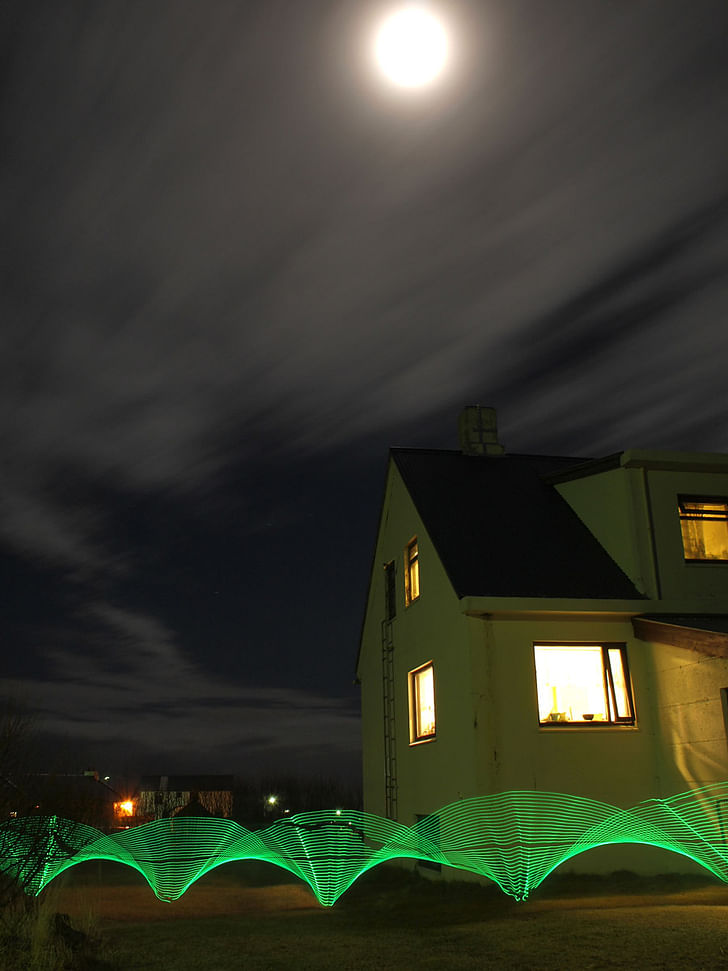
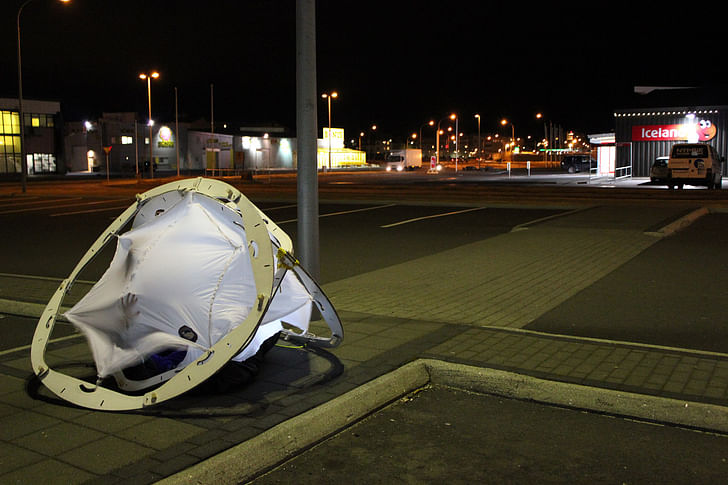
UNIT 3 New Horizons Details:
School: The Bartlett School of Architecture
Year: 2012 - 2013
Unit 3 Directors: David Garcia & Jan Kattein
Students:
Harry Clover
Claire Haugh
Tomiris Kupzhassarova
Shirley Lee
Wenhao Li
Lisa McDanell
Bethany Penman
Cassidy Reid
Sam Tan
Ivo Tedbury
Timmy Whitehouse
No Comments
Block this user
Are you sure you want to block this user and hide all related comments throughout the site?
Archinect
This is your first comment on Archinect. Your comment will be visible once approved.